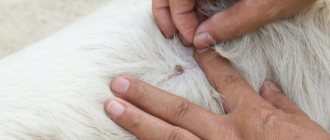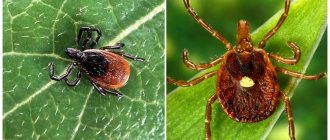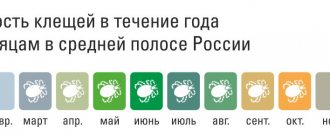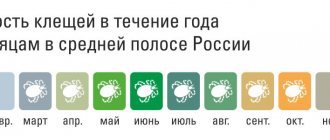Why are ticks dangerous for dogs?
These parasites feed on blood. To do this, they have a specially shaped mouthparts - with a proboscis and hook-shaped spines. With these spines, the insect pierces the dog's skin and is held there, and with its proboscis it sucks out the blood. During a bite, the parasite injects a secretion that reduces pain. This saliva may contain microorganisms that cause serious illnesses: ehrlichiosis, borreliosis or Lyme disease, babesiosis or piroplasmosis. All these diseases are severe and cannot be cured at home. At the first symptoms, be sure to contact your veterinarian.
Regardless of whether a tick is a carrier of pathogenic bacteria, it should not be left on the dog’s body:
- It will disturb the animal.
- It can go deep under the skin and cause inflammation, like a foreign body.
- A tick that has drunk blood is easy to crush. If it is infected, the infection can spread not only to the animal, but also to the owner.
Further actions
After the tick has left the dog's body, it must be taken to the laboratory for examination. This will help determine whether the tick was contagious. If not, then you can simply breathe a sigh of relief, and if the tick was contagious, then it is necessary to begin treatment immediately, before symptoms of piroplasmosis or borreliosis begin to appear. The faster this happens, the greater the animal's chances of life.
You need to monitor your dog's condition in any case. If she has become lethargic, inactive, and does not eat well, then she needs to be shown to a veterinarian.
IMPORTANT! Dogs should not be vaccinated for a week after a tick bite. It is worth moving them and not traveling out of town during this time, so as not to expose the animal to the risk of being bitten again.
If you find a dead tick on your pet’s body, the actions to take with it are the same. The tick needs to be taken to the laboratory, and the dog to the veterinarian. This is done because the dog could gnaw the tick with its teeth, thereby becoming infected, since the infection enters the blood through the esophagus.
When and where to look for ticks in fur
In summer and autumn, when parasites are active, you need to examine your dog after every walk.
Short-haired dogs are especially susceptible to ticks, but long, dense hair will not protect against parasites. They just choose areas where the fur is a little shorter. This could be: the muzzle, ears, belly and groin, paws, especially between the toes, next to the pads.
The pet's body must be carefully examined as a whole, without missing individual areas. You can use a comb to part the fur and look as close to the skin as possible. To detect the smallest tick that has not yet had time to suck blood, you can take a magnifying glass.
Capsules with vitamin E and almonds
In case your dog has ticks near his eyes or ears. This home remedy to eliminate them is what you need. Both almond oil and vitamin E are products that are gentle on your pet's skin and will not cause irritation when used in natural solutions. It is very important to avoid almond essential oil here.
To make this natural tick repellent:
- Mix 20 ml almond oil with a vitamin E capsule.
- Inject the solution into a dropper jar.
- Place a few drops on the affected area of your ears and massage very gently.
- It is important that you avoid introducing the mixture into the animal's ear canal and try to apply the product only in the outer area.
- To apply it to your eyes, dampen gauze or a damp cloth with repellent.
This is how we should take care when applying near sensitive parts of the dog.
How to rid a dog of a parasite
To remove a tick you need to prepare:
- wash and disinfect your hands, wear sterile or disinfected gloves;
- calm and secure the dog, it is advisable to wear a muzzle, even if the pet is very peaceful: no one knows how the animal will behave in a stressful and painful situation;
- It is advisable to carefully trim the hair at the site of the bite;
- prepare an antiseptic for treating the wound.
If your dog is nervous, he may be feeling pain from the parasite. To soften it, you can treat the skin around the bite with lidocaine.
What not to do
To remove ticks from dogs, different methods are recommended. You can't just pull it out. There is a high probability that you will tear off the body of the tick, but the head will remain in the dog’s body. Removing one head is much more difficult at home. And if it is not removed, it will become a source of inflammation.
To remove ixodid ticks, some people advise pouring gasoline, oil, or other viscous or caustic liquids over them. This, of course, will kill the tick, but in agony it can go even deeper under the skin, secreting an increased amount of saliva with pathogenic bacteria. That is, it will only get worse.
You should also not remove a tick simply with your hands. In this case, you can not only tear the insect apart, leaving the head, moreover, when removed, the tick’s body, inflated with blood, will tear. If the tick is on the head, then infected blood can get on the mucous membrane in the mouth, nose, and eyes. It can get on wounds on the body of a dog or person. And because of this, the infection process will worsen.
So, you can’t pull out a tick:
- filling it with oil, gasoline, etc.;
- pulling it out in one motion;
- removing it by hand, without special tools.
The main task is to remove the entire tick without damaging it or leaving parts of it in the animal’s body.
Heyletiella
This is a family of mites with several species. All of them are extremely contagious and dangerous for both animals and humans. The disease is caused by cheyletiellosis (wandering dandruff).
You can become infected through contact. In addition, flies and fleas carry ticks on their paws. Cheyletiella are very small. Their body length varies from 0.25 to 0.5 mm. Once on the skin of its victim, the parasite begins to actively multiply. Symptoms of infection:
- small reddish pimples on the skin;
- dandruff (contains live mites);
- peeling;
- itching (sometimes may be absent).
If this type of tick is found on a dog, what should you do? First, you need to minimize tactile contact with the animal. You cannot pick him up or allow him to lie on your bed or on the sofa. It is recommended to bathe the dog periodically using shampoos:
- "Sweetheart";
- "Gamma";
- "Demos Lux".
Another treatment option is to treat the animal with solutions of the following drugs:
- "Butox";
- “Unoiled.”
You can also use aerosols:
- "Acrodex";
- "Ciodrine";
- "Psoroptol."
With any treatment regimen, you need to inject the animal with Gamavit or its analogues.
Methods for removing ticks
There are several methods on how to properly remove a tick:
- With tweezers . You can use a regular one, but a curved one is more convenient. It needs to be heated over a fire or disinfected in some other way. The tweezers should be held as close to the dog's skin and parallel to it as possible. The parasite is grabbed not by the abdomen, but by the head. It is not pulled out, but twisted, like a loose tooth, rotated from side to side.
- With a thread . This is a more complex method. A loop is formed from the thread, which is used to wrap around the swollen parasite, like a noose. You also need to pull it out gradually, rocking it from side to side. The method is dangerous because the thread can easily crush the insect and cut off its head.
- Using a syringe . To do this, you need to place a syringe without a needle and with a cut off tip to the dog’s body so that the tick is inside. By pulling out the piston you will create a vacuum. If the tick is not held too tightly, you can pull it out entirely. This method rarely helps, but you can try.
- Twister . This is a special device that looks like a small nail puller. It is found in stores under different names, but their operating principle is the same. They need to pick up the tick and slowly pull it out, making light twisting movements. The advantage of this method is that the parasite remains in the twister, and you don’t have to worry about crushing or tearing it. All dog owners who walk their pets in parks and forests should have such a device so that after a tick bite they can pull it out themselves as quickly as possible.
Removing a tick using tweezers or thread
It is important to take the procedure as carefully as possible. To pull out the bloodsucker, you can use ordinary threads. A loop is made from such a thread, which is carefully draped over the tick. When the loop is located close to the insect's proboscis, you need to tighten the knot and, without much effort, gradually pull the thread perpendicular to the skin. If you gently and gradually pull without jerking, the tick may come off.
You can also use tweezers to pull out the tick, with the help of which the insect is captured between the head and the human body. It is important to control not to grab the insect by the abdomen, as this increases the risk of crushing it.
The tick is pulled out gradually, by slowly pulling around the axis (you can twist it either clockwise or counterclockwise). If successful, the tick will be completely pulled out after 1 – 3 turns.
how to remove a tick correctly
How to remove a tick under the eye
Dogs also have thin skin under their eyes. The difficulty in removing ticks from this area is that the dog most likely will not allow any manipulation of itself. She will jerk her head, because of which, firstly, you can get tweezers, a twister or a syringe in the eye, and secondly, you can crush or tear the tick. To remove the parasite, you need one person to hold the head tightly, and the other to pull out the insect.
If you have a helper and can secure the dog's head, try to remove the pest yourself. If you are afraid that you are not a good judge and may harm your pet, it is better to contact a veterinarian.
Detailed symptoms of the lesion
From the moment of infection to the onset of the disease, it takes from several hours to several weeks (sometimes several months and even years). Signs appear:
- apathy, lethargy, inactivity, loss of appetite (up to complete refusal of food);
- discoloration (pallor, yellowing) of the gums;
- darkening, redness of urine;
- increased temperature;
- nosebleeds;
- movement disorders (claudication);
- sore eyes, yellowing of the sclera;
- fever;
- vomiting;
- ring erythema;
- enlarged lymph nodes;
- neurological exacerbations (convulsions, paralysis);
- malfunctions of the respiratory system;
- swallowing disorders;
- bleeding.
The absence of pronounced symptoms cannot be ruled out.
What to do if your dog won't let you remove a tick
If an animal is worried, it means it is in pain. It is necessary, firstly, to calm him down, and secondly, to numb the site of the tick bite. Near the parasite, you can anoint the skin with lidocaine, which is sold as a spray or in ampoules. There is no need to inject it, just apply it to the skin. This is a local anesthetic; it will not harm the animal and will not in any way affect the process of removing the tick, but will reduce pain.
If possible, it is worth carrying out the procedure together, so that one person holds the dog, fixes it, does not allow it to move, and the second is engaged in extracting the parasite. This will be faster, easier and safer for your pet.
You should not give your dog pills or other sedatives without the advice of a veterinarian.
Once the tick is pulled out, it must be disposed of. If possible, you can put it in an airtight jar and send it for analysis to make sure it is not infected. This must be done within two days while he is alive. If it is not possible to send for analysis, the tick must be destroyed, taking precautions. To be safe, you can burn it.
When you have removed the tick, make sure that no parts of it remain on your pet's body. The wound must be washed with chlorhexidine, hydrogen peroxide, iodine or any antiseptic. It is not recommended to use green stuff.
What to do with the dog after removal? Observe her well-being and behavior. The incubation period for diseases transmitted by ticks can be 5–10 days. During this time, it is forbidden to vaccinate the animal and overload it physically. If a dog refuses food, gets tired quickly, lies in a certain place for a long time without showing usual physical activity, the whites of its eyes and skin have turned yellow, and its breathing quickens, you should immediately contact a veterinary clinic. Diseases caused by ticks can be fatal quite quickly.
What to do with a tick?
A live tick (mandatory) is transferred to a special laboratory to be tested for the presence of infectious agents. The arachnid is placed in a container, tightly closed with a lid, providing access to oxygen. If more than 48 hours have passed since the bite, the parasite is highly likely to die.
The dead tick is burned. The same is done in cases where it is not possible to deliver a live bloodsucker to a medical facility. To avoid direct contact with the parasite, gloves and other protective equipment are used.
What to do if your head comes off
If the tick's head or part of it remains under the skin, these remains must be removed. If possible, it is better to contact a veterinarian who will make an incision, remove everything and treat the wound. But if this is not possible, you can remove the head yourself using a fire-heated needle. They pick up the head like a splinter and pull it out. The main thing during this procedure is that the dog does not get nervous. You can treat the area around the wound with an anesthetic, such as lidocaine spray. After removing the head, the wound must be washed and disinfected.
If, some time after extraction, a lump forms at the site of the bite, this indicates that the head or part of it was not completely removed. An inflammatory process with suppuration began in the wound. In this situation, you need to go to the clinic to have the wound cleaned. You may have to make an incision to do this. To avoid this, the entire tick must be removed, and after removal, make sure that no parts of it remain inside the animal.
Prevention methods
To avoid having to remove the tick from the dog’s body, it is worth protecting the pet. For this purpose, there are acaricidal drops on the withers. Anti-tick tablets and special collars impregnated with tick-repellent compounds are also sold. If your dog is walking on a private dacha, it is worth treating it yourself against ticks. For this you can use, for example, Medilis-Ziper.
Working aqueous emulsions are prepared immediately before use. To do this, the product is mixed with tap water from nearby bodies of water, stirring constantly and evenly for 5 minutes. The finished emulsion should be used within 8 hours. To apply the product, spray equipment is used, designed to spray solutions and emulsions of insecticides over surfaces. The effectiveness of the product against ticks in the grass litter is about 1–1.5 months. If there is a significant amount of precipitation, the effectiveness of the product may decrease. If necessary, due to the presence of ticks in the treated area, it can be re-treated.
Also, before a walk, you can treat the fur and collar or clothing (if the dog walks in clothes) with a repellent, for example, produced by MediLIS Laboratories LLC with the acaricidal-repellent agent Medilis-Comfort. Clothes and other fabric and leather products should be processed in the open air (outdoors). Place clothing and direct the product stream in the direction of the wind. Spray on products from a distance of 20 - 25 cm from them, holding the package in an outstretched hand at the rate of 1 press on the spray head per area of 10 cm X 10 cm (1 dm2). Dry the clothes (at least 2 hours) and put them on. Re-process clothes after 15-20 days or after washing. When using chemicals, you must strictly follow the instructions and do not allow the dog to lick itself after application. Medilis-comfort, produced by the manufacturer in a convenient aerosol package, is effective against fleas, midges, midges, mosquitoes, horse flies, mosquitoes, adults, and Ixodes ticks.
What to do after extraction
Under no circumstances should you treat the wound before removal, but after it is very necessary. Any antiseptic or alcohol will do. You can use brilliant green or iodine, but they cause a burning sensation and the dog will try to lick them off. If the parasite was caught alive, it should be placed in a jar with wet cotton wool. And store in a cool place. After a maximum of 48 hours, it must be sent for examination. If the tick does not survive, then you need to give it away as soon as possible. But not all laboratories take a dead specimen. DNA is not stored for long and every minute there is less and less chance of determining whether it was infected.
After this, watch your pet. The slightest deviations: apathy, lethargy, refusal to eat, vomiting, changes in the color of urine - a reason to run to the veterinarian. In this case, the clock counts. You can protect your dog from attack using various means: collars, drops on the withers, repellents. Even a suit can save your pet. And of course, an inspection after every walk, then your dog will never experience the misfortune of diseases brought by ticks.











